The commercial with the meathead that keeps rambling, “I pick things up and put them down,” makes me chuckle every time I see it. For one, it is humorous. On a more realistic note, it is kind of true when it comes to the world of strength training. Specifically, the perception of getting strong.
Anyone with time, intensity, and some level of vanity can become strong — it’s proven in almost every gym around the world. But the first question should be, “At what price?” And the second question, “Does that strength serve a purpose?”
What Toddlers and the Neurodevelopmental Sequence Teach Us
Usually the price paid is pain, injury, and feeling like an eighty-year-old every morning, unless that meathead mentality is abandoned and strength is approached as a skill. The subtleties of loading a movement pattern are where the skill of strength lies, not in the mere fact that weight is moved and gravity is momentarily overcome. One of these subtleties is blending the neurodevelopmental sequence into strength training.
How many people have shoulder pain that is associated with strength training? According to some, that number can be as high as four out of five people. Seems a bit high to me, but it points to a significant problem — a lot of people are hurting themselves by “picking things up and putting them down.” As adults, we assume we are smarter and better educated than when we were children. In most instances that is correct, except for when it comes to moving — and strength training (when done right is) is loaded movement.
Any toddler could give a workshop to adults on how to move well. Who taught us how to move when we were infants? No one! We learned it on our own and only progressed to higher-level movement skills when we had mastered the lower-level movement skills. We went from lying flat on our back to overcoming gravity and walking within twelve to fourteen months. That’s significant improvement in a short time frame.
How does the neurodevelopmental sequence have anything to do with the skill of strength and shoulder injuries? When was the last time you saw a two-year-old with shoulder pain just from being active? They push up, roll, run, fall, hang from things, pull up, fall again, and make it impossible for adults to match what they do. All injury free. Why is this?
First, they are given unlimited mobility — that is our gift at the time of birth. The progression to overcome gravity is essentially us developing the stability to support all that mobility we were blessed with. If stability is not gained, movement doesn’t happen and the neurodevelopmental sequence hits a speed bump — until stability is found. So, great mobility with a progressive increase in stability — sounds like a great recipe for authentic movement and getting stronger.
How the Plank Relates to the Neurodevelopmental Sequence
How can we apply this to being a grown-up and picking things up and putting them down? More to the point, how do we apply this in a manner to develop the skill of strength specifically to improve shoulder stability when pressing (horizontally or vertically)? Let’s look at the basic plank — or what people often “call” a plank.
Ask anyone to do a plank and they will know what you are talking about. The question is what will they give you for technique? Usually, you will get something that resembles a plank but with scapulas that look like the dorsal fins from jaws and/or an arch in the low back reminiscent of a dehydrated cartoon horse traipsing across the desert. Nevermind their head position (probably sagging to the ground) or the fact they are turning blue from holding their breath.
So, how does this have anything to do with the neurodevelopmental sequence?
- Breathing — Breath holding is a survival mechanism, specifically surviving a position or movement that compromises the body. Not good to hold the breath — unless we are talking high-level lifters who have mastered their breath skills to enhance their performance, but we are a long way from that in a plank.
- Prone position — This may be the most important position during the neurodevelopmental sequence that no one acknowledges. This position is where we establish the first weight-bearing joint in the body — the AC joint of the shoulder. This lays the foundation for language skills, writing, fine motor skills of the hand, and upper body strength. A lot going on in such a simple position.
- Hand position — After the face and the genitals, the hands and feet take up the most sensory space in brain. Meaning we get a ton of sensory information that affects our movements from our hands and feet.
- Transitional Stability — Kind of an oxymoron, but the key to the neurodevelopmental sequence is being able to carry the gained stability to the next postural level. Being stable in the presence of movement is huge in the case of pressing loads away from the body. Scapular movement (instability) when the arm is moving a load is the recipe for disaster.
The Press Plank: How This All Relates to Your Pressing
Now, how does one apply this to pressing? At a barbell workshop taught by Pavel and Jeff O’Connor, Jeff made the statement of “always be press ready” when pressing. Seems simple, but again the subtleties raise their head and this is one of the subtleties that carries dramatic effects to performance and shoulder health. The shoulder is the most unstable joint in the body and the most mobile — not a great combination. Keeping pelvis, trunk, and scapular stability during the press movement is vital to pressing strength and shoulder health.
Pressing from a standing plank is the ideal press posture, but how does one transfer a plank to a pressing, standing plank? My solution — the press plank. You need a smooth floor, socks (or a towel), and an attention to detail.
Here are the steps:
1. Begin lying flat on your belly with your arms in the rack position (you will be laying with your arms tucked under you, hands below your chin, elbows tight to the ribs) and your feet on the smooth surface.
2. Tighten everything from the glutes to the toes (hip extension, knee extension, ankle dorsiflexion).
3. Tighten the abs (do it right and the belly will lift off the ground, without a change in position at the shoulders.)
4. Dig the elbows into the ground and press your body away from your hands maintaining the high total body tension.
5. Breathe deep into the belly though the nose. Inhale on the way toward the ground, exhale sharply through pursed lips on the press portion. At the top position, take a nice deep diaphragmatic breath through the nose without losing any tension.
Essentially, with the press plank we are manipulating gravity — we are establishing a great plank position and pressing (it’s funny how starting in the position that babies start in on their belly and pressing back like they do to get up on their knees locks the scapula to the trunk, almost like we were designed for that to happen). Nail this, then stand up and recreate it. Standing plank, press ready, now press!
For Jimmy (my photo subject), a former college football player training with me for a regional football combine, this practice resulted in two things:
- Improving his 225 bench press reps from 11 to 18 in just four weeks (not long enough to physiologically develop more strength). Also, this was a personal record for him. Keep in mind he had four years of strength training while in college at a mid-major university.
- A disappearance of shoulder discomfort with anything overhead that had nagged him his entire collegiate career.
Give it a try! Who knew reverting back to a toddler could help you press.
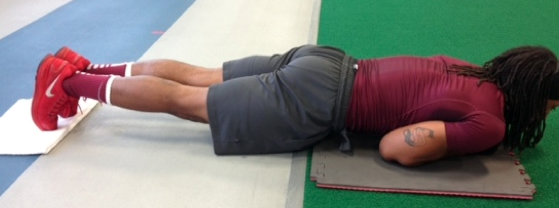
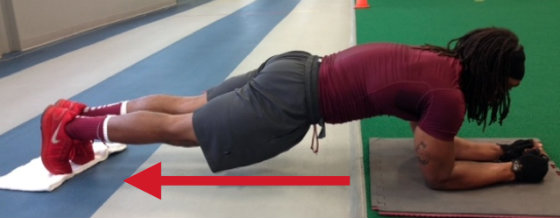
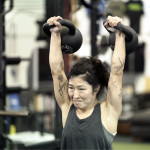
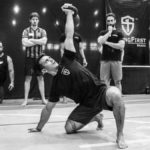

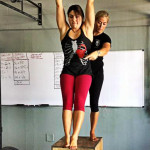


I want to thank you very much Brandon.
I got my right shoulder injured in my sport and for 2 months nothing seemed to help.
It is now 10 days I ‘ve been practicing your drill and after the pain of the first days doing it now my shoulder is getting better and better and today for the first time I felt no pain.
Your drill will be always part of my training.
Wow 🙂
Brandon, would doing this with the feet on an Airex pad change the drill too much? We have mostly carpeted floors and that is way more accessible then getting into our wooden floor area. I would go paper plate route, but they inevitably got all over the place.
VERY cool article and idea. Can’t wait to play with this one Brandon.
Enjoy! I’ve got a few other variations of this I’ve been playing around with since I wrote the article. I’ve had a lot of people also comment on how this also affects the top position of their snatch. Hadn’t expected that.
Great to remind adults of their natural born right to move free as a kid. Aweseome information here. Thanks for taking the time Brandon!
Great drill Brandon, thanks. How many sets and reps would you recommend? Does it matter when one does it? Is it best as a warm-up, between sets, any old time, or all of the above?
Keep in mind this is a drill to improve a skill – the press. If it is challenging, then more work is needed on the drill – it should be fairly low stress. Fatique should not be the goal of this drill. Once there is proficiency in the drill, move on and use it to get dialed in between sets of presses or prior to pressing- whatever works best for the person. Surprisingly, keeping a neutral spine for the duration of the movement can be a bit of a challenge for a lot of people.
I like this drill, Brandon. Thank you for your work.